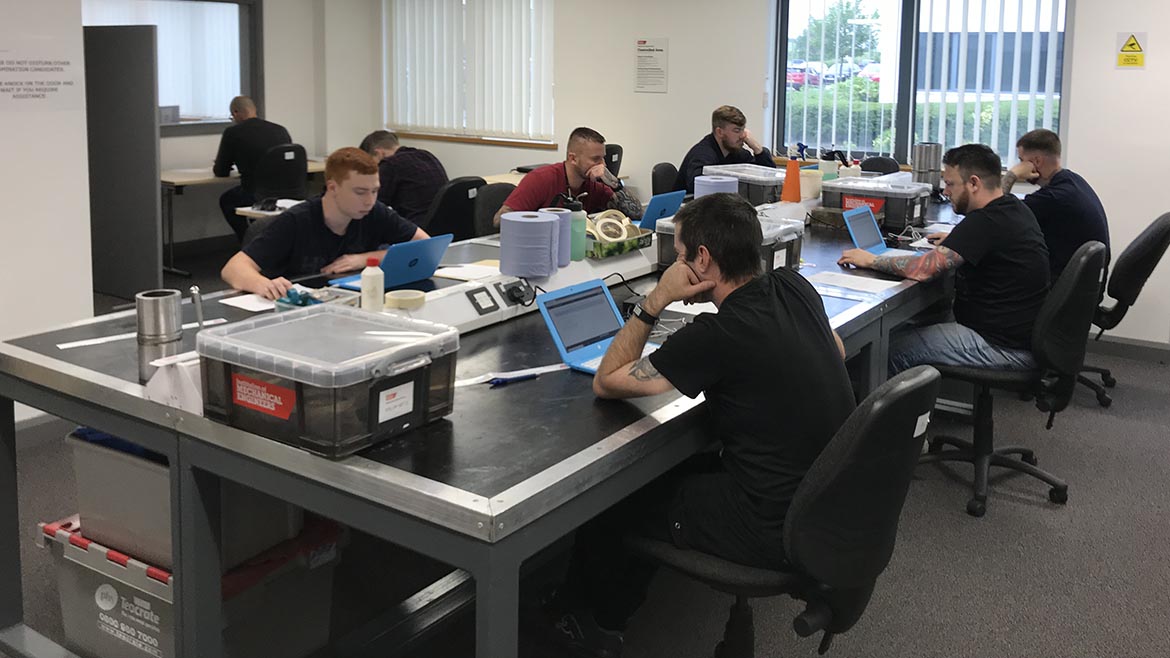The qualification and certification of nondestructive testing (NDT) personnel is driven by one primary objective: to ensure safe and correct application of the NDT task.
When asking the question: “which certification system is best?”, we must draw the reader’s attention to the availability of several international standards that exist to ensure aspirant NDT technicians have received all appropriate theoretical and practical training within the NDT method and have garnered the required amount of practical industrial experience prior to being certificated by the certification body, the British Institute of Non-Destructive Testing (BINDT).
This article is intended to provide guidance on the certification options available through BINDT for ‘central certification’ under the PCN banner, which comply with BS EN ISO 9712:2022. However, it will also touch upon other certification systems, such as those employer-based (second-party) certification schemes, which comply with standards such as EN 4179, NAS 410 and/or SNT-TC-1A.
As NDT evolves, it is typical for the personnel certification requirements attributed to the NDT methods, technologies and techniques to also evolve, ensuring the continued competence of persons required to test such things as aerospace components, oil and gas installations, to name just a few industry sectors where NDT is used on a daily basis. BINDT’s certification scheme, known as PCN, is currently making the transition from BS EN ISO 9712:2012 to the latest version released in 2022. In making this transition, BINDT has had to consider revising and amending its current PCN certification scheme documents, which provide certification across all NDT methods.
Compared to the 2012 edition, amendments incorporated within the 2022 standard include:
- Clarified responsibilities for the certification body, the authorized qualification body, the examination center and the employer.
- Additional definitions.
- Defined responsibilities for examiners and referees.
- Revised requirements for the duration of training and industrial experience.
- Modified requirements for visual acuity.
- Revised requirements for examinations.
- Revised requirements for the certification documents and conditions of certification.
- Added requirements for the renewal of certificates.
- Revised structured credit system for Level 3 recertification.
- The inclusion of a new annex f for NDT techniques.
The latest revision affects aspirant and current PCN certificate holders, and also BINDT’s network of Approved Training Organizations (ATOs) and Authorized Qualifying Bodies (AQBs), with AQBs providing the facilities necessary to examine candidates within a controlled environment to meet the minimum requirements from within the standard.
All PCN certification is third-party certification, meaning that the certification held is owned by the certificate holder, unlike second-party or employer-based certification schemes where certification is provided by and owned by the employer. However, in this brief article we will examine both second- and third-party certification schemes available for use within the worldwide marketplace which, when used in conjunction with one another, can be tailored to meet the needs of industry, the individual and employer to provide immense latitude.

Second-Party / Employer-Based Certification
SNT-TC-1A is one example of second-party certification, which can be convenient for companies where NDT is limited by specific application. It may also be suitable for companies where specialized equipment and/or techniques are routinely used that may not be found outside the specific employer’s business needs. However, it must be noted that the certification is only valid so long as the individual is employed by the company the training and examinations were developed for. When the individual moves to another organization operating other certification systems, they would be expected to be re-examined on the new employer’s equipment and techniques in use within the new facility. Thus, second-party certification systems may require the candidate to have additional formal training prior to being authorized to carry out NDT for a new employer unlike central certification, which allows the individual to carry the certification to a new inspection company when changing employers, ie it exhibits portability.
The American Society for Nondestructive Testing (ASNT) offers certification systems based on SNT-TC-1A, which is the recommended practice for personnel qualification and certification in nondestructive testing.
SNT-TC-1A provides a framework for each employer to develop their own in-house procedure or ‘Written Practice’ for the qualification and certification of NDT personnel within their organization. The Written Practice describes in detail how the employer will provide for the qualification and certification of their personnel. As such, the Written Practice is the key element to any employer-based certification scheme, detailing the company’s commitment to providing adequate training, qualification and certification of their NDT personnel.
Like PCN certification, SNT-TC-1A describes three categories of qualification for individuals engaged in NDT, Levels 1, 2 and 3, and just like central certification all personnel must be recertified periodically in accordance with the standard adopted, typically at periods not exceeding five years. SNT-TC-1A has served as the foundation for a number of other certification schemes such as CP-189 and NAS 410 / EN 4179 used within the aerospace sector.
Benefits Of SNT-TC-1A
- It requires employers to analyze and document their program.
- The Written Practice demonstrates employer responsibility to train and formally examine personnel.
- It implies customer responsibility to review and evaluate the Written Practice.
- It provides a basic certification approach referenced in contracts.
- It may offer the employer the flexibility to modify (ie by either increasing or reducing the certification requirements to meet specific needs).
Limitations Of SNT-TC-1A
Remaining impartial, BINDT does not provide SNT-TC-1A certification; however, BINDT does provide secretariat services to the UK National Aerospace NDT Board (UKNANDTB), whose certification system uses the second-party certification standard EN 4179.
Employers can apply the recommendations of SNT-TC-1A in its entirety or reduce the recommendations to suit the company’s purpose. The result is that most employers have different Written Practices for the certification of their NDT personnel, which may become an expensive undertaking for small companies that employ NDT personnel on a short-term contract basis and which may have to meet several key steps outlined below:
- The employer develops a Written Practice for the qualification and certification of personnel.
- The employer verifies the candidate has met the educational, training and experience requirements for the specific method for which certification is sought.
- The candidate shall be tested to verify that the knowledge and skills required for certification exist, a multistep process consisting of the following elements:
- General theory examination.
- Specific theory examination to verify knowledge of the specific products tested.
- Hands-on practical examination.
- Confirmation of visual acuity and color perception.
ISO 9712:2012 Compliant Central Certification
The Certification Services Department of BINDT administers PCN central certification in accordance with the internationally recognized standard BS EN ISO 9712, which establishes a system for the qualification and certification of personnel engaged in NDT through a central independent body referred to as the Certification Body (CB). In this instance, BINDT is the CB and provides audit oversight to a number of ATOs to administer approved training packages developed in accordance with experts within the field of NDT and from specific training syllabuses[1] to standardize and provide assurances to the candidate and employer as to the content of any derived training package. The requirements being that candidates shall successfully complete an approved course of structured training required to achieve a satisfactory end-of-course assessment. To confirm this, ATOs will provide candidates and their employers with documentary proof of successful or unsuccessful completion of training, together with a recommendation as to the candidate’s preparedness for future examination.
Where candidates are considered suitable for PCN examinations, an examination may be booked at one of PCN’s AQBs who, like ATOs, are rigorously assessed by independent audit teams under the scrutiny of an appointed lead assessor to ensure the highest standards of professional service, security and confidentiality required of an examination system are maintained.
The AQB is defined as: ‘A body, independent of any single predominant interest, authorized by the Independent Certifying Body to prepare and administer examinations to qualify NDT personnel’.
Where training, practical industrial experience and success in the relevant PCN examination elements listed below have been demonstrated, certification may then be issued:
- Written general knowledge examination element.
- Written specific knowledge examination element for the NDT method applied to specific products tested.
- Practical testing examination element (hands-on practical examination).
- Suitability of vision to verify that the candidate meets the physical eyesight requirements of the job, including an annual near vision acuity test and color vision tests every five years.
- Verification of practical industrial experience.
- Confirmation and acceptance of morals and ethics required by PCN (CP27).
Ultimately, the goal of PCN certification is to provide assurances to those who rely on the tests being undertaken (for example end-users, regulators, insurers, etc.) that the tests have been carried out competently within a regulated and controlled environment, and in this regard the PCN scheme meets this criterion, in direct contrast to employer-based certification where each employer administers its own certification tests.
The concept of centralized certification is that it standardizes the requirements for the qualification and certification of personnel. It affords a greater degree of transportability of an individual’s credentials. The program does not require the employer to have a written practice or procedures describing the system of qualification and certification. As an aside and in addition to third-party certification and where the full requirements of BS EN ISO 9712 might be considered too onerous, BINDT is also exploring Limited Certification, again to meet the requirements of BS EN ISO 9712.
Limited ISO 9712 Compliant PCN Certification
BS EN ISO 9712 confirms: ‘Where it is recognized that the scope of an activity is limited in application, then the training scope and duration may be reduced by up to 50%’ and ‘where the certification sought is limited in application (ie thickness measurement or automated testing) experience duration may also be reduced by up to 50%’.
Examples of such limitations include those related to application (for example automated eddy current testing (ET), ultrasonic testing (UT) of bar, tube and rod or normal beam ultrasonic thickness and lamination testing of rolled steel plate) and to technique (for example leak testing only using a bubble test and/or yoke for magnetic particle). Principles may well be transferable to meet the employer’s specific needs for certification where specific PCN appendices are developed to meet the employer’s and/or industry sector requirements for Limited NDT.
Like SNT-TC-1A, where NDT is limited by specific application, this Limited nature of PCN certification may be suitable for those companies where specialized equipment and/or techniques are routinely used, which might not be found outside the specific employer’s business needs, a type of hybrid system that may capture some benefits of both second- and third-party certification systems, respectively, whilst retaining an element of portability.
In conclusion, whatever system of certification is adopted, it shall be the employer’s responsibility to ensure the NDT technician is competent to inspect the employer’s or the employer’s customer’s products, and where competency is lacking, then it is the employer’s responsibility to provide additional specific product training to ensure competence.
Reference:
ISO/TS 25107:2019: Non-destructive testing - NDT training syllabuses


